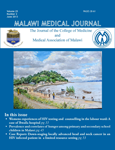
|
Malawi Medical Journal
College of Medicine, University of Malawi and Medical Association of Malawi
ISSN: 1995-7262
Vol. 23, No. 4, 2015, pp. 105-109
|
 Bioline Code: mm11028
Bioline Code: mm11028
Full paper language: English
Document type: Research Article
Document available free of charge
|
|
|
Malawi Medical Journal, Vol. 23, No. 4, 2015, pp. 105-109
| en |
Cytosine Arabinoside reduces the numbers of granulocyte macrophage colony forming cells (GMCFC) and high proliferative potential colony forming cells (HPP-CFC) in vivo in mice
Teleka, Stanley; Chijuwa, Alexander; Senga, Edward & Chisi, John E.
Abstract
Background:
Cytosine arabinoside (Ara-C) is an S-phase specific cytotoxic
drug used in the treatment of malignancies. It is converted to Cytosine
Arabinoside triphosphate (Ara-CTP) in the cell. Cytosine Arabinoside
triphosphate, reversibly displaces deoxy cytidine triphosphate from DNA
polymerase for incorporation into DNA. This process leads to cell death.
Objective:
To investigate the in vivo effects of Ara-C on the Granulocyte
Macrophage Colony Forming Cells (GM-CFC) and High Proliferative
Potential Colony Forming Cells (HPP-CFC) respectively in mice.
Methodology:
Ara-C (150mg/kg) was administered intraperitoneally (i.p)
once to mice and bone marrow cells sampled on days 1, 3 and 6.
Results:
Ara-C reduced the numbers of both GM-CFC and HPP-CFC
in the bone marrow. HPP-CFCs were initially more sensitive to Ara-C
treatment than GM-CFCs. In the six days after treatment the effect on
GM-CFC persisted, while there was a partial recovery in the number of
HPP-CFCs.
Conclusion:
It is possible that Ara-C disturbs the stem cells niche by
damaging the stromal cells of the bone marrow microenvironment. This
would result in derangement of HPP-CFC proliferation.
|
| |
© Copyright 2011 - Malawi Medical Journal
Alternative site location: http://revista.uft.edu.br/index.php/jbb/index
|
|
